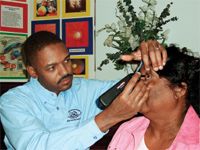Article
Exam, therapy adherence vital after initial screening
Glaucoma screenings can help identify people who may have the disease to encourage them to receive care. Ophthalmologists must stress to participants the importance of seeking that care and adhering to any subsequently prescribed therapy. Vision loss from glaucoma occurs with the death of the retinal ganglia cells that travel from the optic nerve to the brain. Therefore, a current goal is to identify sick cells that try to "rescue" them by lowering IOP. For the future, however, the hope is to be able to regenerate cells that have been sickened by the disease.

Key Points

After five different medications failed to stop the progression of the disease, Martin was placed in a clinical trial for bimatoprost 0.03% (Lumigan, Allergan).
It was a life-changing moment for Martin, he said: 12 years ago, as a member of his local Lions Clubs International, he dove into community service to enlighten everyone around him about the benefits of glaucoma screenings. The pharmaceutical company making his medication heard about his passion and brought him on as a paid consultant. Today, Martin speaks to doctors and volunteer groups across the country about community service and sets up glaucoma screenings through local Lions clubs.

Education key
"Education is the strongest component of any glaucoma screening," said Martin, who conducts about 120 screenings and 20 dinner lectures annually. He said his efforts have led to more than 160,000 people being screened in 46 states in the past 10 years.
Martin said he organizes screenings though local physicians, bringing a "screening-in-a-box" to the location. His "box" includes frequency-doubling technology, tonometers, Snellen charts, hand sanitizer, extension cords, power strips, alcohol wipes, registration forms-everything for a complete vision screening, short of refractions.
He met his wife, Marie Keorner, at one of those screenings. The couple married within a year and honeymooned in Toronto, conducting a glaucoma screening for the Seventh-Day Adventists' World Conference. The couple helped screen 3,100 people from 131 different nations in 7 days. It was at this event that Marie had her eyes screened and a tumor on her retina was detected. She underwent a successful procedure to remove the tumor.
"We've discovered brain tumors and all sorts of things that have intervened in saving peoples' lives," Martin said of their efforts over the years. When people say glaucoma screenings aren't cost effective, I say, 'What's the value of a human life?' My own wife's life was saved. How great a gift was that?"
The point of screenings
Joel S. Schuman, MD, director of the University of Pittsburgh Medical Center Eye Center, said, "The point of the screening is to find people who are likely to have glaucoma and then encourage them to see or receive additional care-or care itself." Dr. Schuman is principal investigator of a National Institutes of Health (NIH) grant to study novel methods of glaucoma diagnostics and is a co-investigator of an NIH grant for research into optical diagnostics and short-pulse laser surgery. He and his colleagues were the first to identify a molecular marker for human glaucoma.
"People who are identified by screening need to be made aware of the importance of care for glaucoma, and that they need to have a more thorough exam to ensure glaucoma is present," Dr. Schuman added.





